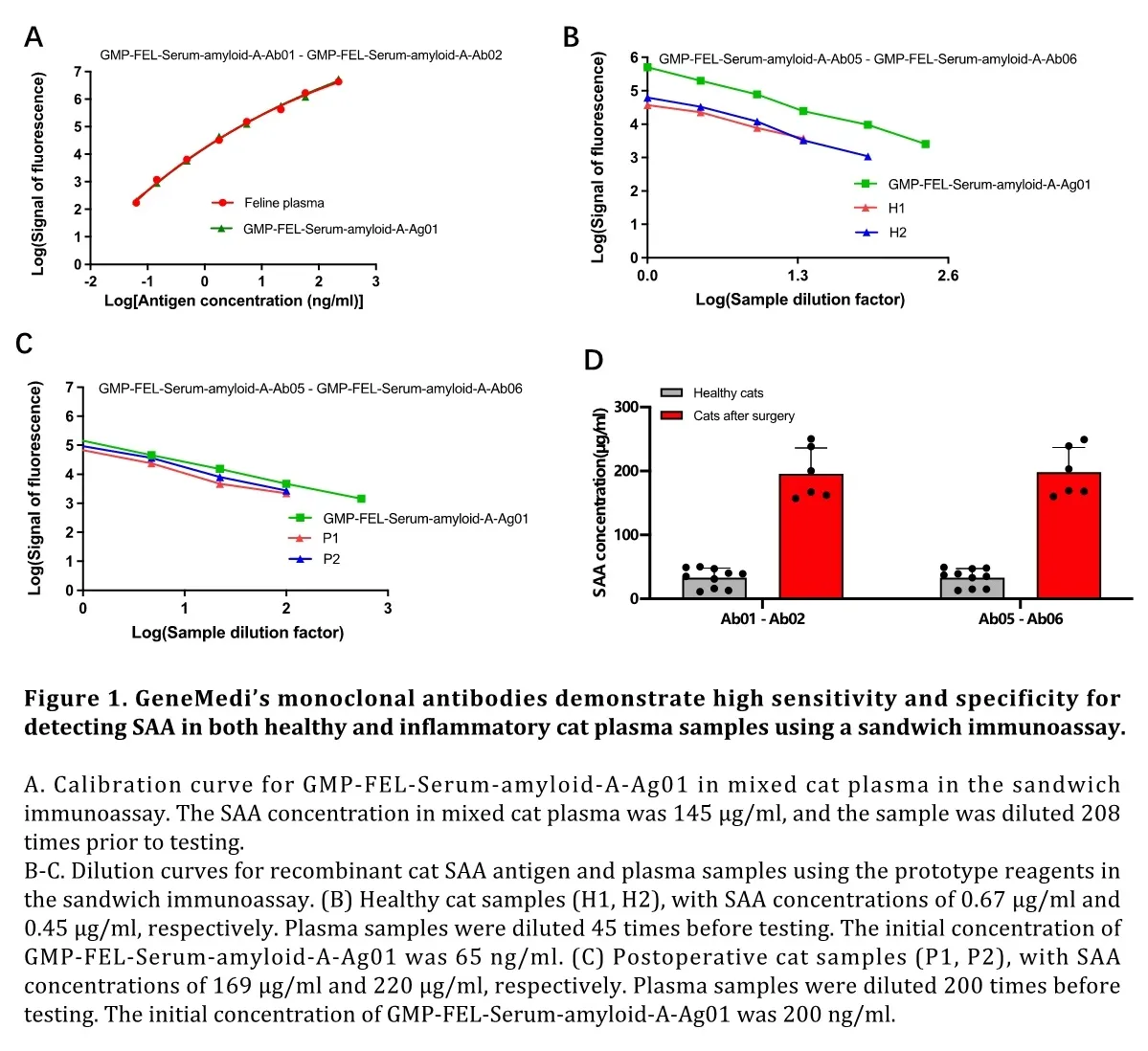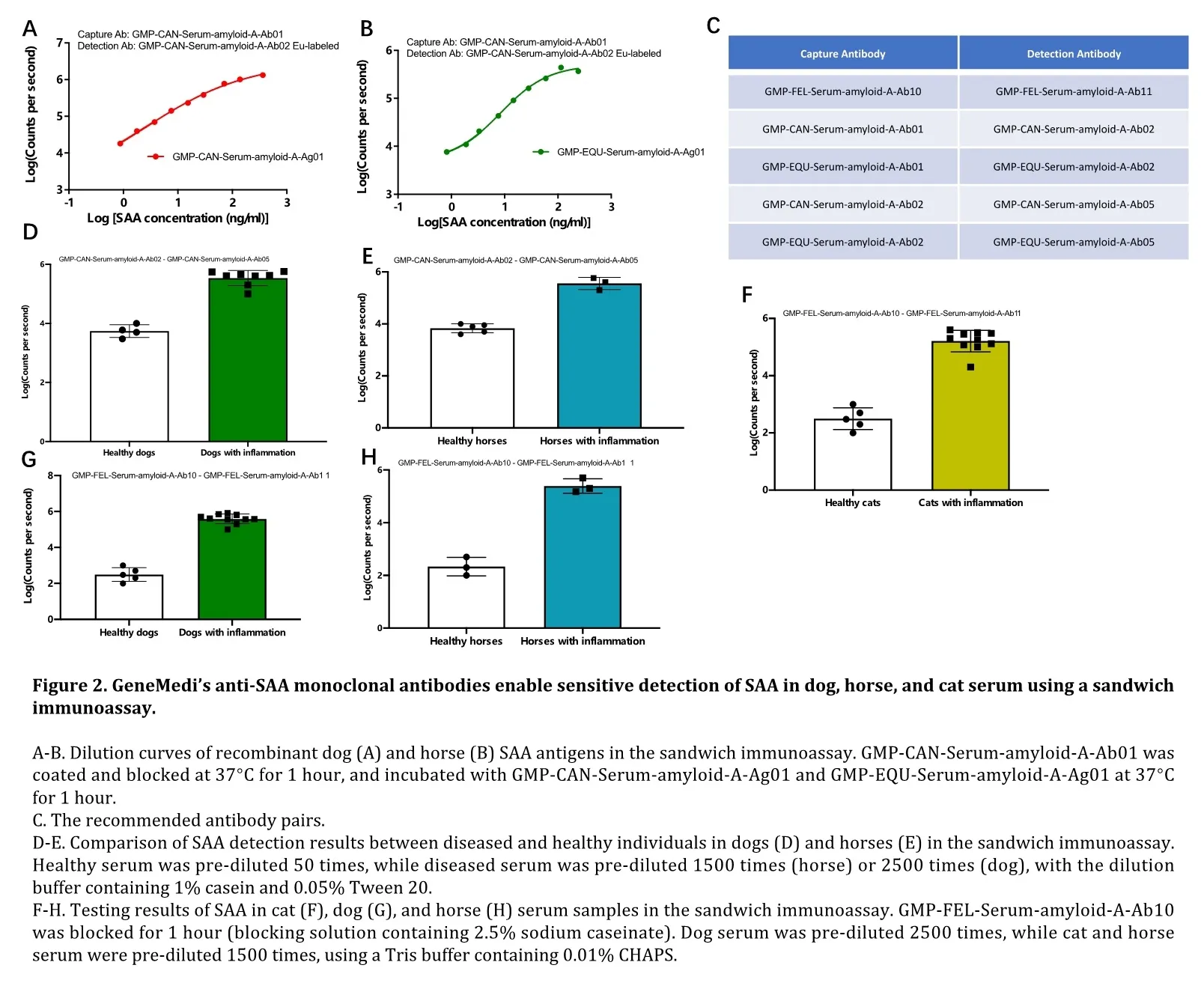Feline Serum amyloid A antibody and antigen (recombinant protein) GMP-FEL-Serum-amyloid-A
Diagnostic anti-Feline Serum amyloid A antibodies pairs and antigen for animal health (animal Cat/Feline Acute inflammation, infections) testing in ELISA, colloidal gold-based Lateral flow immunoassay (LFIA), CLIA, TINIA and POCT
 Go to Acute inflammation, infections diagnostics products collection
>>
Go to Acute inflammation, infections diagnostics products collection
>>
Product information
Size: 1mg | 10mg | 100mg
| Catalog No. | Description | US $ Price (per mg) | First Order Discount | First Order Discount Price |
|---|---|---|---|---|
| GMP-FEL-Serum-amyloid-A-Ag01 | Recombinant Feline Serum amyloid A protein | 3090 | ||
| GMP-FEL-Serum-amyloid-A-Ab01 | Anti-Feline Serum amyloid A mouse monoclonal antibody (mAb) | 1953 | 20% | 1562.4 |
| GMP-FEL-Serum-amyloid-A-Ab02 | Anti-Feline Serum amyloid A mouse monoclonal antibody (mAb) | 1953 | 20% | 1562.4 |
| GMP-FEL-Serum-amyloid-A-Ab03 | Anti-Feline Serum amyloid A mouse monoclonal antibody (mAb) | 1953 | 20% | 1562.4 |
| GMP-FEL-Serum-amyloid-A-Ab04 | Anti-Feline Serum amyloid A mouse monoclonal antibody (mAb) | 1953 | 20% | 1562.4 |
Shipping Costs: $360–$760
Antibodies: $360 Antigens: $760 (Elevated cost due to antigen heterogeneity, post-translational modifications, structural complexity, and specialized handling.)
Product Description
| Cat No. of Products | GMP-FEL-Serum-amyloid-A-Ag01 |
| Product Name | Recombinant Feline Serum amyloid A protein |
| Target/Biomarker | Feline Serum amyloid A (SAA) |
| Expression platform | E.coli |
| Bioactivity validation | Anti-Feline Serum amyloid A antibodies binding, Immunogen in Sandwich Elisa, lateral-flow tests, and other immunoassays as control material in SAA level test of animal Cat/Feline with Acute inflammation, infections. |
| Tag | His |
| Products description | Recombinant Feline Serum amyloid A protein was expressed in E.coli - based prokaryotic cell expression system and is expressed with 6 HIS tag at the C-terminus. |
| Purity | Purity: ≥95% (SDS-PAGE) |
| Application | Paired antibody immunoassay validation in sandwich Elisa, ELISA, colloidal gold-based Lateral flow immunoassay (LFIA), CLIA, TINIA, POCT and other immunoassays |
| Formulation & Reconstitution | PBS liquid / Lyophilized from GM's Protein Stability Buffer2 (PSB2,Confidential Ingredients) or PBS (pH7.4); For PSB2, reconstituted with 0.9% sodium chloride; For PBS, reconstituted with ddH2O. |
| Storage | Store at -20℃ to -80℃ under sterile conditions. Avoid repeated freeze-thaw cycles. |
| Cat No. of Products | GMP-FEL-Serum-amyloid-A-Ab01, GMP-FEL-Serum-amyloid-A-Ab02, GMP-FEL-Serum-amyloid-A-Ab03, GMP-FEL-Serum-amyloid-A-Ab04 |
| Product Name | Anti-Feline Serum amyloid A mouse monoclonal antibody (mAb) |
| Target/Biomarker | Feline Serum amyloid A (SAA) |
| Expression platform | CHO |
| Bioactivity validation | Recombinant Feline Serum amyloid A antigen binding, ELISA validated as capture antibody and detection antibody. Pair recommendation with other anti-SAA antibodies in SAA level test of animal Cat/Feline with Acute inflammation, infections. |
| Tag | mFc |
| Products description | Anti-Feline Serum amyloid A mouse monoclonal antibody (mAb) was expressed in CHO. |
| Purity | Purity: ≥95% (SDS-PAGE) |
| Application | Paired antibody immunoassay validation in sandwich Elisa, ELISA, colloidal gold-based Lateral flow immunoassay (LFIA), CLIA, TINIA, POCT and other immunoassays |
| Formulation & Reconstitution | Lyophilized from GM's Protein Stability Buffer2 (PSB2,Confidential Ingredients) or PBS (pH7.4); For PSB2, reconstituted with 0.9% sodium chloride; For PBS, reconstituted with ddH2O. |
| Storage | Store at -20℃ to -80℃ under sterile conditions. Avoid repeated freeze-thaw cycles. |
Reference
Validation Data
GeneMedi’s anti-SAA monoclonal antibodies demonstrate superior performance in immunoassay.
GeneMedi’s monoclonal antibodies for SAA (Serum Amyloid A) offer high sensitivity for detecting SAA in cat, dog, and horse serum. Due to the high sequence homology among these species, the same antibody pairs can be used to develop versatile sandwich immunoassays. As a result, GeneMedi’s anti-SAA antibodies provide a valuable tool for accurately monitoring and diagnosing inflammatory conditions across multiple species.

Figure 1. GeneMedi’s monoclonal antibodies demonstrate high sensitivity and specificity for detecting SAA in both healthy and inflammatory cat plasma samples using a sandwich immunoassay.
A. Calibration curve for GMP-FEL-Serum-amyloid-A-Ag01 in mixed cat plasma in the sandwich immunoassay. The SAA concentration in mixed cat plasma was 145 μg/ml, and the sample was diluted 208 times prior to testing.
B-C. Dilution curves for recombinant cat SAA antigen and plasma samples using the prototype reagents in the sandwich immunoassay. (B) Healthy cat samples (H1, H2), with SAA concentrations of 0.67 μg/ml and 0.45 μg/ml, respectively. Plasma samples were diluted 45 times before testing. The initial concentration of GMP-FEL-Serum-amyloid-A-Ag01 was 65 ng/ml. (C) Postoperative cat samples (P1, P2), with SAA concentrations of 169 μg/ml and 220 μg/ml, respectively. Plasma samples were diluted 200 times before testing. The initial concentration of GMP-FEL-Serum-amyloid-A-Ag01 was 200 ng/ml.
D. SAA concentrations in healthy and postoperative inflammatory cats. Healthy cat samples were pre-diluted 100-3000 times, while inflammatory cat samples were pre-diluted 9000 times prior to testing.

Figure 2. GeneMedi’s anti-SAA monoclonal antibodies enable sensitive detection of SAA in dog, horse, and cat serum using a sandwich immunoassay.
A-B. Dilution curves of recombinant dog (A) and horse (B) SAA antigens in the sandwich immunoassay. GMP-CAN-Serum-amyloid-A-Ab01 was coated and blocked at 37°C for 1 hour, and incubated with GMP-CAN-Serum-amyloid-A-Ag01 and GMP-EQU-Serum-amyloid-A-Ag01 at 37°C for 1 hour.
C. The recommended antibody pairs.
D-E. Comparison of SAA detection results between diseased and healthy individuals in dogs (D) and horses (E) in the sandwich immunoassay. Healthy serum was pre-diluted 50 times, while diseased serum was pre-diluted 1500 times (horse) or 2500 times (dog), with the dilution buffer containing 1% casein and 0.05% Tween 20.
F-H. Testing results of SAA in cat (F), dog (G), and horse (H) serum samples in the sandwich immunoassay. GMP-FEL-Serum-amyloid-A-Ab10 was blocked for 1 hour (blocking solution containing 2.5% sodium caseinate). Dog serum was pre-diluted 2500 times, while cat and horse serum were pre-diluted 1500 times, using a Tris buffer containing 0.01% CHAPS.
Click to get more Data / Case study about the product.
Target/Biomarker information
SAA, Serum Amyloid A, is a versatile and indispensable biomarker within the context of cats (felines). This protein assumes a central role in the feline immune system's response to inflammatory challenges. Primarily synthesized by hepatocytes in the liver, SAA is swiftly released into the bloodstream in response to various inflammatory signals, including those triggered by infections, tissue damage, or other inflammatory conditions. Structurally, SAA comprises two primary isoforms in cats, SAA1 and SAA2, both of which can be elevated during inflammatory conditions. These isoforms play a pivotal role in modulating the host's immune response to pathogens and injuries. SAA acts as a chemoattractant for immune cells, facilitating their migration to the site of infection or inflammation. Additionally, SAA can influence other immune responses, including the production of cytokines and other inflammatory mediators. In cats, SAA serves as a sensitive and early marker of systemic inflammation. When exposed to inflammatory stimuli, such as infections, tissue damage, or other inflammatory conditions, the liver rapidly increases the synthesis of SAA. Elevated levels of SAA in the bloodstream can be detected within hours of the initial trigger, making it a valuable diagnostic tool for veterinarians.
About GDU

GDU helps global diagnostic partners in high quality of raw material discovery, development, and application. GDU believes in Protein&antibody Innovation for more reliable diagnostic solutions.







Comments
No comments yet.